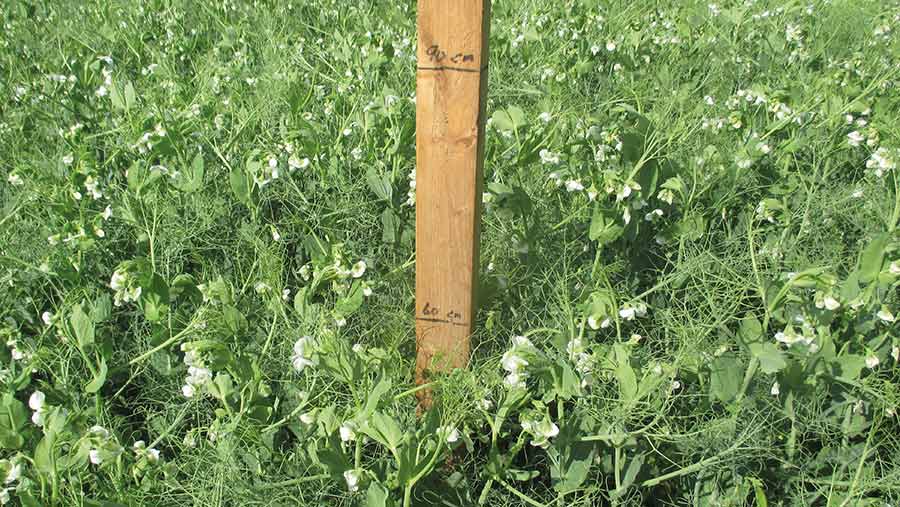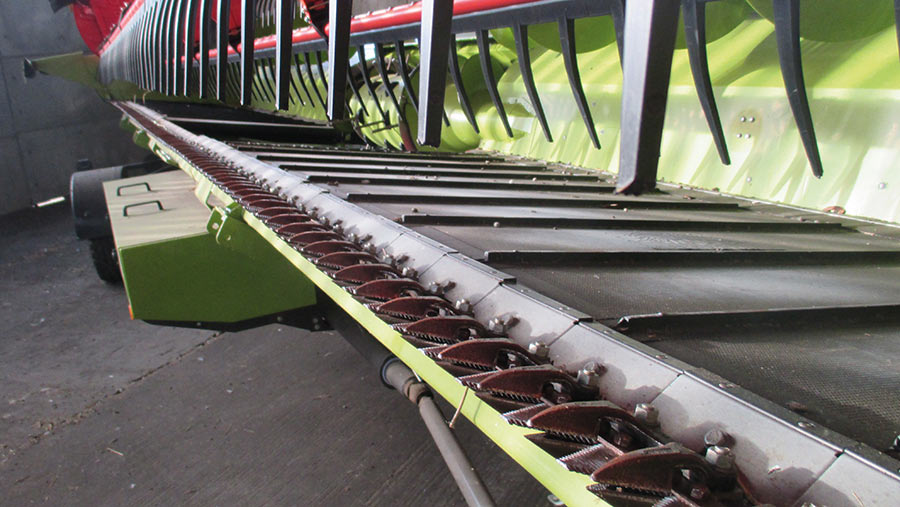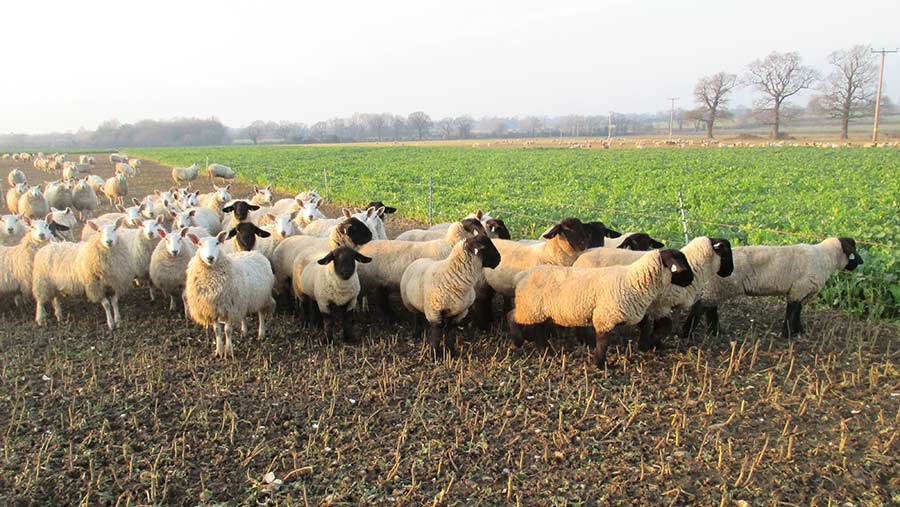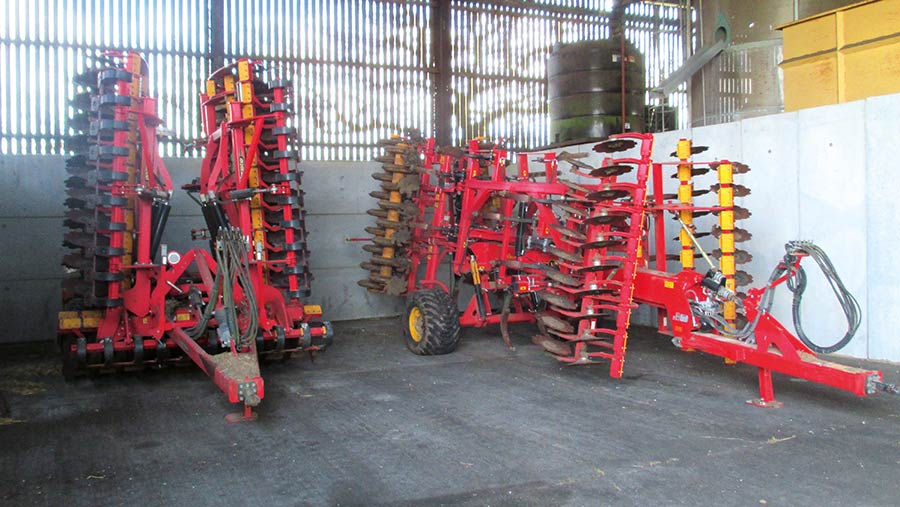Peas increase wheat yields and lengthen OSR rotation
 © Chris Eglington
© Chris Eglington After a 40-year break, Norfolk farmer Chris Eglington reintroduced peas to the farm in a bid to widen his oilseed rape rotation and promote yields of following winter wheats.
The leguminous break crop successfully achieved what Mr Eglington hoped it would, acting as an excellent soil conditioner to increase yields of subsequent milling winter wheat.
Peas also improved both establishment and yield of oilseed rape by extending the rotation to one in eight, which considerably reduced cabbage stem flea beetle pressure.
See also: Essex wheat grower earns extra premium by hitting 14% protein
Growing demand
With demand for pulses growing and new markets opening up, there are considerable benefits and opportunities available to growers.
Given the record high fertiliser price, growing legumes may become particularly appealing as they don’t need any nitrogen fertiliser.
With this in mind, Mr Eglington planted 34ha of the large blue variety Mankato this season, which was drilled into good conditions, with moisture at depth and dust flying on the top.
However, given the volatility of pulse markets, he questions how much longer he will continue to grow the crop at the 400ha farm (285ha of which is cropped), trading as SS Eglington and Son, based at Letton.
“I find myself asking whether I should continue to grow peas. We have to appreciate the price of fertiliser, which is extortionately high, but with oilseed rape now at £800/t, markets will have to adapt for peas to really pay,” he says.

Peas can be difficult to harvest, so a flexi header can help © Chris Eglington
Lack of investment
n fact, when he first grew peas 40 years ago, average yields were 5t/ha. He then dropped the crop from the rotation as he introduced more grass leys for livestock across the farm.
Fast forward to today and his pea yields are no more than they were four decades ago, despite new breeds and developments within the pulse sector.
This is mainly due to the lack of investment and research into the UK pulses and veg legumes sector, explains Roger Vickers , chief executive of the Processors and Growers Research Organisation.
Pulses and legumes are niche crops, with less than 250,000ha grown each year. This niche crop status has, therefore, minimised commercial investment and research funding over the years, meaning crop improvements have been limited.
“On a global scale, an estimated US$175m [£134m] is invested annually in pulses and legumes, compared with billions for crops in the ‘big seven’,” says Mr Vickers.
He point out that supply and demand is often restricted as poor crop data and variable crop quality hampers market developments. “We usually don’t know what area of pulses there is planted until after harvest, when Defra releases its results,” he says.
Despite this uncertainty, markets are evolving and when it comes to creating a sustainable rotation that increases crop productivity and encourages biodiversity, growing pulses can bring huge opportunities and benefits.

Sheep graze stubble turnips, before planting to peas in the spring © Chris Eglington
Establishing peas
When it comes to high-yielding crops, cultivations and establishment are absolutely critical, says Mr Eglington, as pulses are particularly sensitive to compaction.
Last year, when establishing the crop he made two passes before drilling. The first with a Vaderstad Carrier to break up the surface and help the soil dry out after winter, while the second was with a Vaderstad TopDown. This removed a layer of compaction identified at 15cm deep as a result of sheep grazing the prior crop of stubble turnips.
However, he admits that two cultivations are not always necessary and with the cost of fuel rocketing he used just the one TopDown pass, before drilling with a Vaderstad Rapid at a depth of 13cm.
Mr Eglington opts for a high seed rate of 250kg/ha, and uses variable-rate drilling as soil types range from very heavy to relatively light land. This results in variable rate range of 208-267 seeds/sq m.
To further reduce compaction risks and maximise root systems development he uses a 8m controlled traffic farming system with variable-rate tyre pressure set at 0.62bar (9psi) when working on pea ground.
Nutrition also plays a major part. Biosolids are applied after winter barley and in front of stubble turnips, which are in turn grazed by sheep. This eliminates phosphate requirements, but 100kg of polysulphate for sulphur and variable-rate potash are still applied.

With fuel costs rocketing just the one TopDown pass was used © Chris Eglington
When it comes to disease control, a total of two fungicides are applied. One at the early- to mid-flowering stage and the next at post-flowering.
Mr Eglington is a strong believer in on-farm trials, so a number of rates were investigated on different fields. On average this was 0.5 litres/ha Signum (boscalid + pyraclostrobin) followed by 0.375 litres/ha Amistar (azoxystrobin).
He intends to use a similar programme this year, but also trial a three-tired fungicide spray programme and monitor any yield differences. Insecticides are only used if absolutely necessary. However, he notes that one of the main challenges associated with growing peas is harvest.
“Crop losses can be an issue. We definitely grow more in the field than what we harvest, but we use a Claas Flexi header with specific knives for peas to help scoop the crop up,” he says.
The importance of pulse establishment
Iain Ford, business development manager at BASF, says that despite limited industry investment, recent studies have shown pea and bean yield to be significantly influenced by both seed rate and seed weight.
This emphasises the importance of crop management throughout the season, and he highlights a number of key management factors to optimise yield.
First, he stresses the importance of cultivations, rooting and establishment to achieve the optimum plants/sq m.
“Good root systems maximise moisture and nutrient uptake. Research has shown compaction can reduce yield by up to 40% and poor root systems can double the number of drought-stressed days,” he says.
Keeping the canopy clean and disease-free is another key step to increase the rate of photosynthesis to maximise pod and seed set survival.
This is why growers should aim to maintain green leaf area for as long as possible, to enable maximum time for seeds to fill.
Mr Ford suggests a programme comprising two fungicide sprays. He recommends an application of boscalid and pyraclostrobin, which offers good disease control but also brings improvements to photosynthesis, green area index and subsequent yield.
Winter bean fungicide trial
A trial investigating a range of fungicide actives and rates in a crop of winter beans found that a higher rate of Signum (0.75 litres/ha) rather than the standard 0.5 litres/ha at T1 followed by a cheaper azoxystrobin + tebuconazole mix generated the highest yield of 7t/ha. This also came with the greatest margin over fungicide cost (MOFC) at £145/ha (see table right).
The untreated crop was already very high yielding at 6t/ha. When a low-cost azoxystrobin + tebuconazole spray was applied at both T1 and T2, a 0.8t/ha increase was identified and MOFC reached £126/ha.
Replacing the T2 spray with Elatus Era delivered no yield benefit when compared with two applications of azoxystrobin + tebuconazole. With the higher spend on Elatus Era, the MOFC reduced to £107/ha.
When Signum and Elatus Era was applied at T1 and T2, yield increased to 6.9t/ha and the MOFC was £125/ha, while two applications of Signum had the second highest MOFC of £135/ha.
|
Active and rate (litres/ha) |
Yield (t/ha) |
Margin over fungicide cost (£/ha) |
|
T1 Azoxystrobin (0.75) + tebuconazole (0.5) T2 Azoxystrobin (0.75) + tebuconazole (0.5) |
6.8 |
126 |
|
T1 Elatus Era (benzovindiflupyr + prothioconazole) (0.66) T2 Azoxystrobin (0.75) + tebuconazole (0.5) |
6.8 |
107 |
|
T1 Signum (boscalid + pyraclostrobin) (0.5) T2 Elatus Era (0.5) |
6.9 |
125 |
|
T1 Signum (0.5) T2 Signum (0.5) |
6.9 |
135 |
|
T1 Signum (0.75) T2 azoxystrobin (0.75) + tebuconazole (0.5) |
7.0 |
145 |

